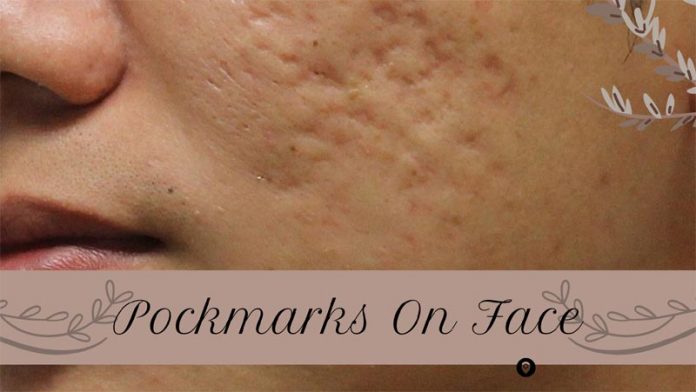Pockmarks, also called pick marks, are red, flea-bitten patches of skin on the body. They are caused when an infection like smallpox/chickenpox or acne damages the deeper skin layers. They are caused primarily due to sudden loss of collagen. Although they can appear anywhere on the face, they are most commonly found on the cheeks, forehead, or chin. They get their name from pock, an archaic word for a hole, and mark, which refers to the fact that they are visible.
As per a survey, facial acne scars or pockmarks are looked down upon by society. Therefore, due to the negative perception, one must prevent acne scars and go for early treatment of inflammatory acne.
This blog post will explain the meaning, causes, and best treatments for pockmarks on the face.
Differences between pockmarks on face and acne scars
Scarring on the skin, particularly on the face, can take the form of pockmarks or acne scars. There are, however, some distinctions between the two.
- Pockmarks are tiny, deep pits or craters on the skin’s surface, whereas acne scars are generally elevated or depressed spots on the skin. Scars from acne can take on many forms, including rolling scars, boxcar scars, and ice-pick scars.
- Pockmarks are frequently formed by severe acne, chickenpox, or skin injury, whereas acne scars are created by inflammation and damage to the skin’s collagen fibres.
- Pockmarks can emerge anywhere on the face, chest, or back, although acne scars are generally limited to the site of the acne outbreak.
- Pockmarks can range in size and depth, and some are fairly severe. Acne scars also vary in intensity, but they are often less severe than pockmarks.
What Causes Pockmarks On Face?
Pockmarks are caused by a variety of reasons, including:
- Infection: Bacteria and germs can infect your skin, causing pockmarks on your face.
- Irritation: Skin irritation might result in pockmarks on your face. This can happen for a variety of causes, including friction from garments on your skin, itching, and so on.
- Allergic responses: Allergic reactions are a common cause of pockmarks on the face. Whenever you suspect you might be allergic to anything, you should see a doctor immediately since it might produce pockmarks on your face.
- Chickenpox: It is a viral illness that causes itchiness and fluid-filled blisters on the skin. These blisters can get infectious if scraped or inflamed, resulting in scarring and pockmarks.
- Injury: Scarring and pockmarks can arise from any skin damage, such as cuts, burns, or abrasions.
- Genetic factors: Some persons may be predisposed to acquiring pockmarks owing to their ancestry, including relatives.
- Aging: It causes the skin to lose proteins called collagen and elastin, which maintain the skin smooth and firm. This can result in the production of wrinkles and fine lines.
How to get rid of Pockmarks on Face? – Treatment Options for Pockmarks
Depending on the source and severity of the pockmark, several treatment methods are available. After evaluating the individual’s skin and needs, a dermatologist can propose the appropriate treatment strategy.
- Chemical Peels: A chemical solution is given to the top layer of skin to exfoliate it and encourage the normal process of exfoliation. It enhances the appearance of pockmarks. Light peels may be performed at home, but deeper peels require expert treatment.
- Microdermabrasion: A diamond-tipped machine exfoliates the skin. Reduces the visibility of pockmarks and other scars. It may be done professionally or at home using a kit.
- Dermal fillers: Injectable compounds used to fill up pockmarks and enhance skin texture are known as dermal fillers. Permanent fillers have lasting results(might have unwanted adverse effects), temporary fillers require touchups, and semipermanent fillers might be the best treatment option. They are primarily beneficial for soft atrophic scars or boxcar types. They can be used alone or with other procedures like fractional laser, chemical peels, or micro-needling.
- Laser resurfacing: Laser resurfacing is the use of laser beams to remove damaged skin and encourage collagen formation. It works best on boxcar scars and might be ineffective on pitted scars. It may help to conceal pockmarks and other scars. Many sessions may be necessary.
- Subcision: A technique in which the fibrous tissue underlying the scar is broken apart, allowing the skin to lift. It is one of the safest techniques to remove scars. It can be safely combined with other treatments like derma roller, laser, and scar revision.
How To Prevent Pockmarks?
- One should go early for treatment that might include antibiotics and non-antibiotic treatments like benzoyl peroxide. Timely treatment can prevent acne from becoming worse and creating scars.
- Topical retinoids are useful in prevention of acne scars
- Silicone gel is also very effective in the prevention primarily of hypertrophic scars and keloids
- Avoid picking or squeezing acne lesions.
- Wear protective clothing and seek shade whenever feasible. Use a broad-spectrum sunscreen with an SPF of 30 or higher.
- Reduce/avoid smoking.
- Maintain a healthy skincare routine. Avoid using abrasive scrubs or exfoliants, which can irritate the skin and aggravate acne.
- Avoid using too many artificial cosmetic products on your face.
- To keep your skin healthy and reduce inflammation, eat a balanced diet rich in fruits, vegetables, and whole grains.
- Reduce stress through exercise, meditation, or deep breathing.
Conclusion
If you or your loved ones have a pockmarked face and want to get rid of it, we suggest you consult a dermatologist of repute. Without specialized treatment, the pockmarks will not heal and may have far-reaching consequences. So don’t hesitate to take the necessary steps towards achieving the smooth and healthy skin you always wanted.
Kolors Healthcare has 50+ clinics across south India and has been in business for over 16 years. Our cutting-edge acne treatment choices provide long-term satisfaction, and our knowledgeable skin specialists give tailored care.
You can start by scheduling an appointment with a dermatologist at the time and location of your choosing.
Pockmarks On Face FAQs
Do pockmarks on the face go away?
Pockmarks on the face may not disappear on their own, but treatments are available to enhance their looks, such as laser resurfacing, chemical peels, and dermal fillers.
What is the best treatment for pitted skin?
The best therapy for pitted skin is determined by the degree of the scarring, with choices including laser treatments, chemical peels, micro-needling, dermal fillers, subcision, or punch excision. For tailored recommendations, consult a dermatologist.
How can I remove holes from my face naturally?
While natural therapies may enhance skin texture, they may not entirely remove pitted scars. Contact a dermatologist for expert treatment options customized to your skin’s needs.









